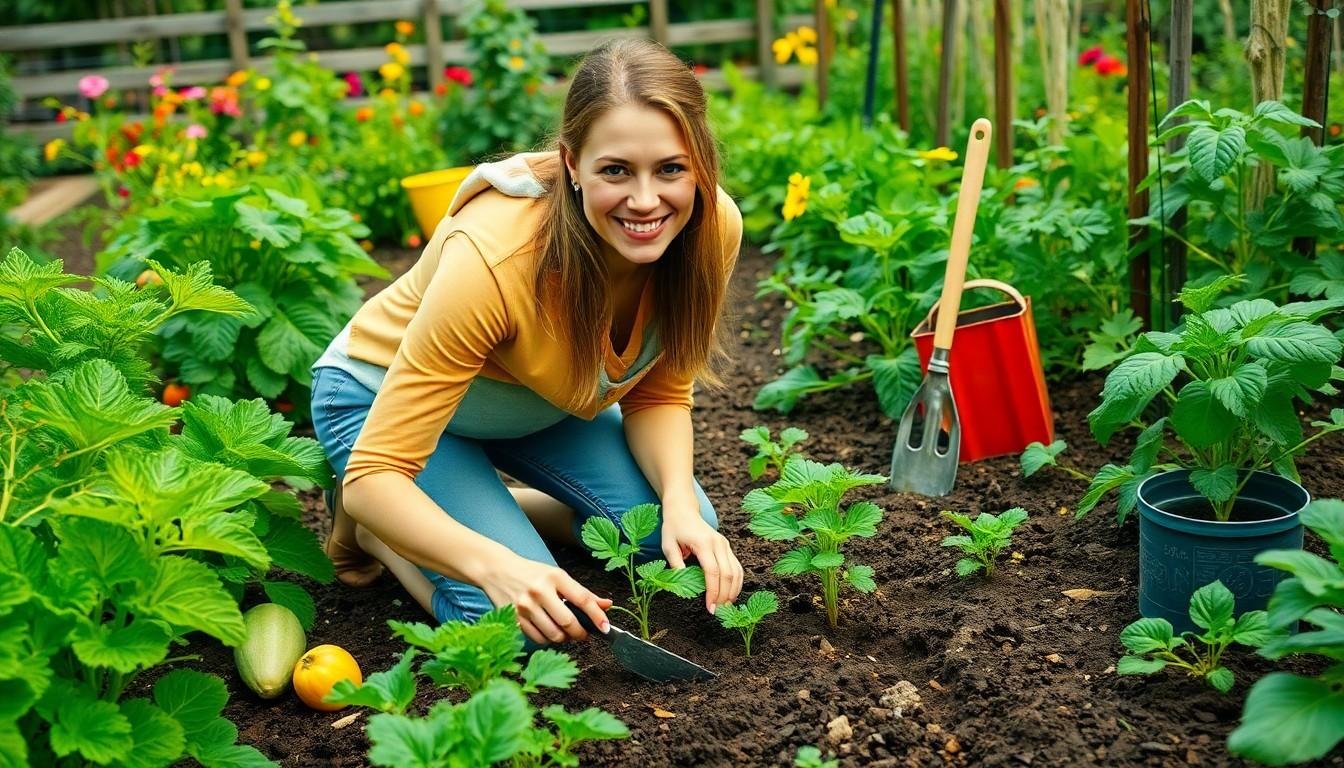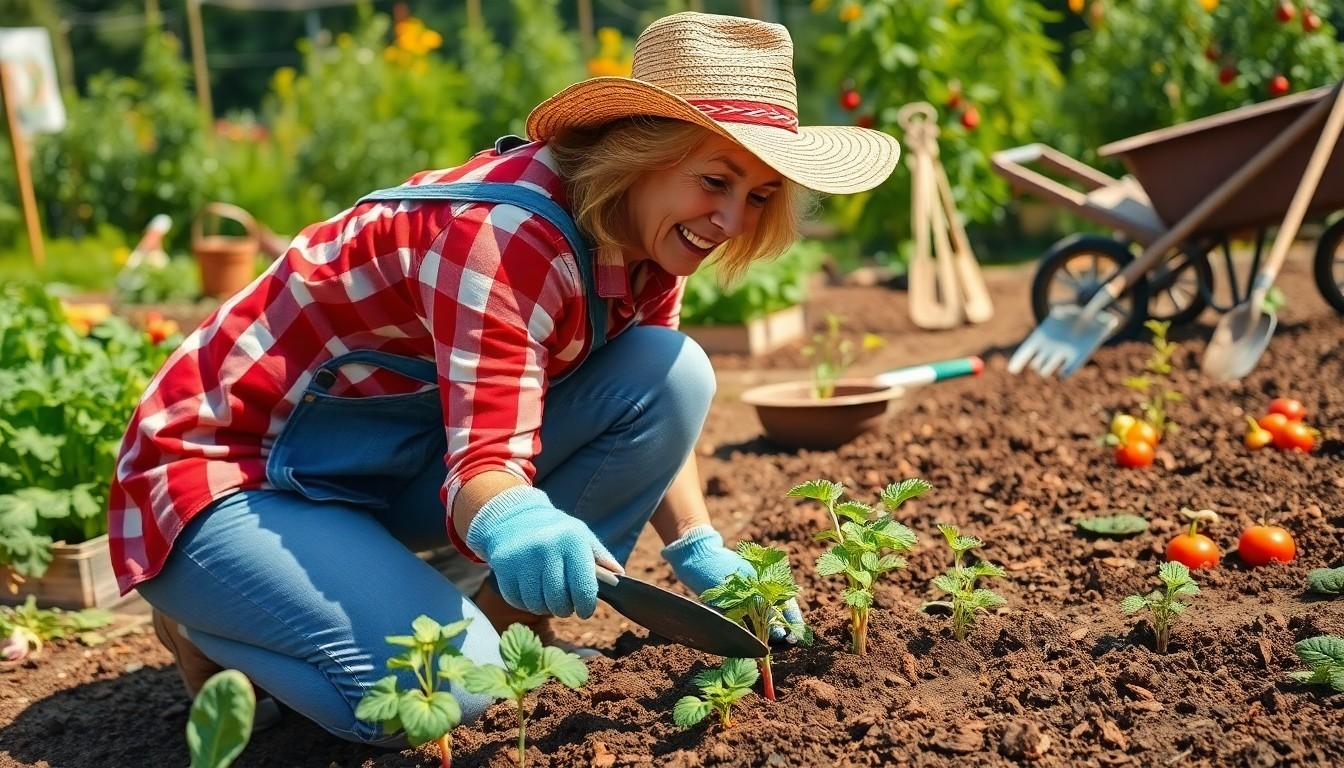Every aspiring gardener knows that the secret to a thriving vegetable garden isn’t just the seeds; it’s the right tools. Imagine trying to bake a cake without a whisk—chaos, right? The same goes for gardening. From trowels that dig deep to hoes that keep the weeds at bay, having the right gear can turn a patch of dirt into a bountiful feast.
Overview of Vegetable Garden Tools
Essential tools enhance the gardening experience, making tasks easier and more efficient. A trowel serves as a fundamental tool, useful for digging holes and planting seedlings. Garden hoes excel at cultivating soil and removing weeds, while hand pruners are vital for maintaining healthy plants.
Quality watering cans or hoses provide necessary hydration. It’s important to choose equipment that’s comfortable to use and suits individual gardening needs. A rake aids in leveling soil, while a shovel assists in moving larger amounts of material.
Additionally, gloves protect hands from thorns and dirt. A garden fork helps to aerate soil, allowing for better nutrient absorption. Wheelbarrows simplify transport, making it easy to move supplies around the garden.
Selecting the right tools leads to a more enjoyable gardening process. Maintenance tools like cultivators and edgers create well-defined garden beds.
Taking care of garden tools should not be overlooked, as proper upkeep extends their lifespan. Storing tools in a dry, organized manner prevents rust and damage. Understanding the specific purpose of each tool allows for a more productive garden experience.
Overall, having a collection of the right vegetable garden tools streamlines various gardening activities.
Essential Tools for Vegetable Gardening

Essential tools make vegetable gardening efficient and enjoyable. A well-equipped garden allows for easier planting, maintenance, and harvesting.
Hand Tools
Hand tools serve as the backbone of any vegetable garden. Trowels facilitate digging and transplanting seedlings. Garden hoes provide effective weed removal and soil cultivation. Pruners keep plants healthy by promoting proper growth. Selecting ergonomic hand tools minimizes fatigue and enhances productivity. Rakes help level soil and remove debris, making it easier to prepare garden beds. Gloves protect hands from thorns and dirt, ensuring comfort during gardening tasks.
Power Tools
Power tools introduce efficiency to larger vegetable gardens. Rototillers turn over soil, reducing manual labor while preparing beds for planting. String trimmers effectively manage grass and weeds along garden edges, enhancing aesthetics. Electric leaf blowers clear debris quickly, keeping the garden tidy. Garden vacuums assist in collecting leaves and plant material, simplifying clean-up. Choosing the right power tools based on garden size fosters optimal productivity and allows for more focused work on plant care and growth.
Specialized Vegetable Garden Tools
Specialized vegetable garden tools play a crucial role in maximizing efficiency and productivity. Gardeners benefit significantly from investing in the right tools for specific tasks.
Weeders
Weeders efficiently remove unwanted plants and weeds that compete with vegetables for nutrients. A handheld weeder features a long, narrow blade designed for precision, allowing easy access to tight spaces. Another popular type is the oscillating hoe, which cuts weeds just beneath the soil surface, minimizing disturbance to nearby plants. Additionally, the forked weeder is effective at loosening soil and extracting deep-rooted weeds. Proper usage of these tools greatly reduces the need for harmful herbicides, ensuring a healthier garden environment.
Pruners
Pruners are essential for maintaining the health and productivity of vegetable plants. Bypass pruners create clean cuts on stems, promoting faster healing and reducing disease risk. Anvil pruners, on the other hand, provide strong leverage for cutting through thicker branches. Regular pruning encourages better air circulation and light penetration, ultimately benefiting plant growth. Moreover, high-quality pruners feature ergonomic handles that enhance comfort and reduce hand fatigue. Gardeners can keep plants thriving through effective pruning techniques using the right tools.
Maintenance and Care of Tools
Maintaining tools ensures they perform optimally and last longer. Regular cleaning removes dirt and debris that can cause rust. After each use, gardeners should wipe soil from blades and handles. Storing tools in a dry location prevents moisture buildup. Rust can significantly diminish a tool’s effectiveness and structural integrity.
Sharpening cutting tools enhances precision and reduces effort. Gardeners should periodically check pruners and hoes for sharpness, sharpening them with a whetstone when necessary. Proper adjustment of handles and blades keeps tools functional. For power tools, it’s essential to inspect cords and batteries for wear.
Daily inspections of hand tools for damage ensures safe operation. Broken handles or bent blades pose both safety and usability risks. Replacing damaged parts promptly is crucial to prevent accidents.
Applying oil to metal parts protects against rust and improves operation. A light coating of vegetable or machine oil keeps blades moving smoothly. Additionally, maintaining wooden handles with linseed oil helps retain their strength and prevents cracking.
Lastly, using toolboxes or organizers helps keep tools accessible. Neat arrangement minimizes the risk of damage and makes finding the right tool quick and easy. Taking time for proper maintenance translates into fewer repairs and a more efficient gardening experience.
Choosing the Right Tools for Your Garden
Selecting the right tools significantly enhances vegetable gardening. Focus on comfort and efficiency when evaluating options available in the market. Trowels excel at digging holes and transplanting seedlings, making them fundamental for any gardener. Hoes assist in soil cultivation and weed removal, essential for healthy growth.
Rakes enable soil leveling and debris removal, while shovels excel at moving larger amounts of material. Garden forks provide effective aeration, facilitating nutrient absorption. Ergonomic tools minimize fatigue, allowing for longer gardening sessions without discomfort.
Power tools can streamline larger tasks. Rototillers prepare soil quickly, while string trimmers manage edges effectively. Garden vacuums and electric leaf blowers assist in debris clearance, saving time and effort.
Specialized tools can further increase efficiency. Handheld weeders tackle unwanted plants, ensuring minimal disturbance to neighboring crops. Pruners, either bypass or anvil types, cater to different cutting needs, essential for maintaining plant health. Regular pruning promotes air circulation, spurring growth.
Maintaining tools is crucial for sustaining performance. Regular cleaning prevents soil buildup, while storage in dry locations protects against rust. Inspecting tools for damage before each use enhances safety and efficiency. Sharpened cutting tools provide precise results, contributing to a well-maintained garden.
Using toolboxes or organizers ensures easy access and minimizes the chance of damage. Prioritizing a comprehensive collection of hand and power tools, alongside specialized equipment, fosters a successful gardening experience. This careful selection process leads to improved productivity and plant care.
Conclusion
Having the right vegetable garden tools is crucial for any gardener aiming for success. These tools not only simplify tasks but also enhance the overall gardening experience. By investing in quality equipment and ensuring proper maintenance, gardeners can maximize productivity and promote healthy plant growth.
Selecting ergonomic and specialized tools tailored to individual needs makes a significant difference in comfort and efficiency. With the right tools at hand, gardening becomes a more enjoyable and rewarding endeavor. Embracing both hand and power tools leads to a thriving vegetable garden, allowing gardeners to focus on nurturing their plants and enjoying the fruits of their labor.

